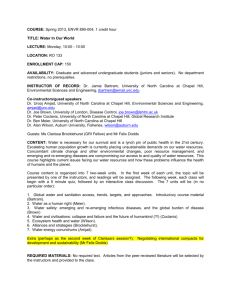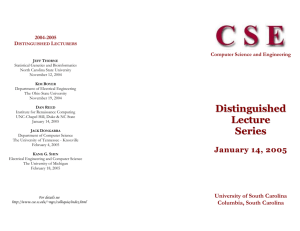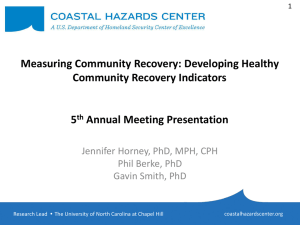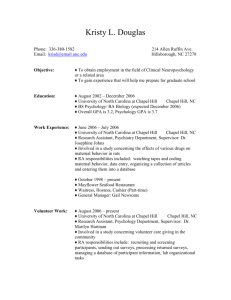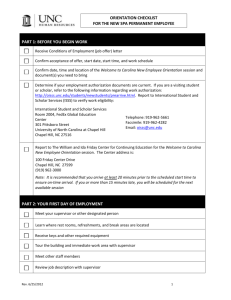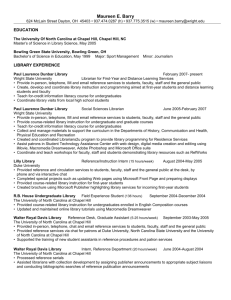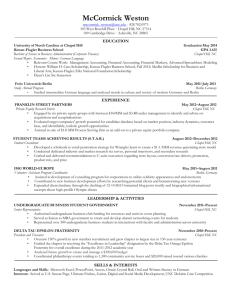slides - University of North Carolina at Chapel Hill
advertisement
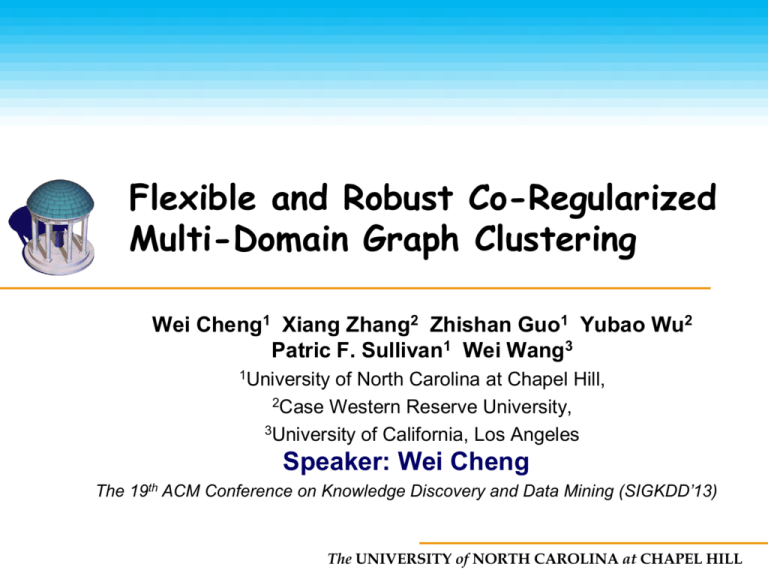
Flexible and Robust Co-Regularized Multi-Domain Graph Clustering Wei Cheng1 Xiang Zhang2 Zhishan Guo1 Yubao Wu2 Patric F. Sullivan1 Wei Wang3 1University of North Carolina at Chapel Hill, 2Case Western Reserve University, 3University of California, Los Angeles Speaker: Wei Cheng The 19th ACM Conference on Knowledge Discovery and Data Mining (SIGKDD’13) The UNIVERSITY of NORTH CAROLINA at CHAPEL HILL Outline • Introduction • Motivation • Co-regularized multi-domain graph clustering Single domain graph clustering Cross-domain Co-regularization Residual sum of squares (RSS) loss Clustering disagreement (CD) loss • Re-evaluation cross-domain relationship • Experimental Study • Conclusion The UNIVERSITY of NORTH CAROLINA at CHAPEL HILL Graph and Graph Clustering • Graphs are ubiquitous social networks biology interaction networks literature citation networks, etc • Graphs clustering Decompose a network into sub-networks based on some topological properties Usually we look for dense sub-networks The UNIVERSITY of NORTH CAROLINA at CHAPEL HILL E.g., Detect protein functional modules in a PPI network from Nataša Pržulj – Introduction to Bioinformatics. 2011. The UNIVERSITY of NORTH CAROLINA at CHAPEL HILL E.g., Community Detection Collaboration network between scientists from Santo Fortunato –Community detection in graphs The UNIVERSITY of NORTH CAROLINA at CHAPEL HILL Multi-view Graph clustering • Graphs collected from multiple sources/domains • Multi-view graph clustering Refine clustering Resolve ambiguity The UNIVERSITY of NORTH CAROLINA at CHAPEL HILL Motivation • Multi-view Exact one-to-one Complete mapping The same size • More common cases Many-to-many Tolerate partial mapping Different sizes Mappings are associated with weights(confidence) The UNIVERSITY of NORTH CAROLINA at CHAPEL HILL Motivation • Objective: design algorithm which is Flexibility Robustness Flexibility and Robustness Suitable for common cases : Many-to-many weighted partial mappings Noisy graphs have little influence on others The UNIVERSITY of NORTH CAROLINA at CHAPEL HILL Problem Formulation affinity matrix A(1) A(2) A(3) Sa,b(i,j) denotes the weight between the a-th instance in Dj and the b-th instance in Di. To partition each A(π) into kπ clusters while considering the co-regularized constraints implicitly encoded in cross-domain relationships in S. The UNIVERSITY of NORTH CAROLINA at CHAPEL HILL Co-regularized multi-domain graph clustering (CGC) • Single-domain Clustering Symmetric Non-negative matrix factorization (NMF). Minimizing: L( ) || A( ) H ( ) ( H ( ) )T ||F 2 ( ) ( ) ( ) ( ) T s.t. H ( ) 0 n k Here, H [h1* , ha* ,..., hn * ] R , where each ha(* ) represents the cluster assignment of the a-th instance in domain Dπ The UNIVERSITY of NORTH CAROLINA at CHAPEL HILL Co-regularized multi-domain graph clustering (CGC) • Cross-domain Co-regularization Residual sum of squares (RSS) loss (when the number of clusters is the same for different domains). Clustering disagreement (CD) loss (when the number of clusters is the same or different). The UNIVERSITY of NORTH CAROLINA at CHAPEL HILL Co-regularized multi-domain graph clustering (CGC) • Residual sum of squares (RSS) loss Directly compare the H(π) inferred in different domains. To penalize the inconsistency of cross-domain cluster partitions for the l-th cluster in Di, the loss for the b-th instance is Jb(i,l, j ) ( E (i , j ) ( xb( j ) , l ) hb(,jl) )2 where E (i , j ) ( xb( j ) , l ) 1 (i , j ) (i ) S b , a ha ,l (i , j ) ( j) | N ( xb ) | aN ( i , j ) ( xb( j ) ) N ( i , j ) ( xb( j ) ) denotes the set of indices of instances in Di that are mapped to x ( j ) , and | N (i , j ) ( xb( j ) ) | is its cardinality. b The RSS loss is k nj (i , j ) J RSS J b(i,l, j ) || S (i , j ) H (i ) H ( j ) ||2F l 1 b 1 The UNIVERSITY of NORTH CAROLINA at CHAPEL HILL Co-regularized multi-domain graph clustering (CGC) • Clustering disagreement (CD) Indirectly measure the clustering inconsistency of cross-domain cluster partitions . Intuition: • A⃝ and B⃝ are mapped to 2⃝, and C is mapped to 4⃝ . Intuitively, if the similarity between cluster assignments for 2⃝ and 4⃝ is small, then the similarity of clustering assignments between A⃝ and C⃝ and the similarity between B⃝ and C⃝ should also be small. (i , j ) The CD loss is J CD || S (i , j ) H ( i ) ( S ( i , j ) H ( i ) )T H ( j ) ( H ( j ) )T ||2F Linear kernel The UNIVERSITY of NORTH CAROLINA at CHAPEL HILL Co-regularized multi-domain graph clustering (CGC) • Objective function (Joint Matrix Optimization): d H min ( ) 0(1 d ) o L(i ) i 1 (i , j ) J (i , j ) ( i , j )I Can be solved with an alternating scheme: optimize the objective with respect to one variable while fixing others. The UNIVERSITY of NORTH CAROLINA at CHAPEL HILL Re-Evaluating Cross-Domain Relationship • The cross-domain instance relationship based on prior knowledge may contain noise. • It is crucial to allow users to evaluate whether the provided relationships violate any single-domain clustering structures. The UNIVERSITY of NORTH CAROLINA at CHAPEL HILL Re-Evaluating Cross-Domain Relationship • We only need to slightly modify the co-regularization loss functions by multiplying a confidence matrix W (i , j ) JW(i , j ) || (W ( i , j ) S ( i , j ) ) H ( i ) H ( j ) ||2F d Optimize: W 0, H min ( ) 0(1 d ) o L(i ) i 1 ( i , j )I (i , j ) JW(i , j ) Sort the values of W(i,j) and report to users the smallest elements. The UNIVERSITY of NORTH CAROLINA at CHAPEL HILL Experimental Study • Data sets: UCI (Iris, Wine, Ionosphere, WDBC) Construct two cross-domain relationships: Iris-Wine, Ionosphere-WDBC, (positive/negative instances only mapped to positive/negative instances in another domain) Newsgroup data (6 groups from 20 Newsgroups) comp.os.ms-windows.misc, comp.sys.ibm.pc.hardware, comp.sys.mac.hardware, (3 comp) rec.motorcycles, rec.sport.baseball, rec.sport.hockey (3 rec) protein-protein interaction (PPI) networks (from BioGrid), gene co-expression networks (from Gene Expression Ominbus), genetic interaction network (from TEAM) The UNIVERSITY of NORTH CAROLINA at CHAPEL HILL Experimental Study • Effectiveness (UCI data set) The UNIVERSITY of NORTH CAROLINA at CHAPEL HILL Experimental Study • Robustness Evaluation (UCI) The UNIVERSITY of NORTH CAROLINA at CHAPEL HILL Experimental Study • Re-Evaluating Cross-Domain Relationship (UCI) The UNIVERSITY of NORTH CAROLINA at CHAPEL HILL Experimental Study • Binary v.s. Weighted Relationship The UNIVERSITY of NORTH CAROLINA at CHAPEL HILL Experimental Study • Binary v.s. Weighted Relationship The UNIVERSITY of NORTH CAROLINA at CHAPEL HILL Experimental Study • Protein Module Detection by Integrating Multi-Domain Heterogeneous Data 490032 genetic markers across 4890 (1952 disease and 2938 healthy) samples. We use 1 million top-ranked genetic marker pairs to construct the network and the test statistics as the weights on the edges 5412 genes The UNIVERSITY of NORTH CAROLINA at CHAPEL HILL Experimental Study Protein Module Detection: • Evaluation: standard Gene Set Enrichment Analysis (GSEA) we identify the most significantly enriched Gene Ontology categories significance (p-value) is determined by the Fisher’s exact test raw p-values are further calibrated to correct for the multiple testing problem The UNIVERSITY of NORTH CAROLINA at CHAPEL HILL Experimental Study • Protein Module Detection: Comparison of CGC and single-domain graph clustering (k = 100) The UNIVERSITY of NORTH CAROLINA at CHAPEL HILL Experimental Study • Protein Module Detection: The UNIVERSITY of NORTH CAROLINA at CHAPEL HILL Conclusion • In this paper… We propose a flexible co-regularized method, CGC, to tackle the many-to-many, weighted, partial mappings for multi-domain graph clustering . CGC utilizes cross-domain relationship as coregularizing penalty to guide the search of consensus clustering structure. CGC is robust even when the cross-domain relationships based on prior knowledge are noisy. The UNIVERSITY of NORTH CAROLINA at CHAPEL HILL Thank You ! Questions? The UNIVERSITY of NORTH CAROLINA at CHAPEL HILL Experimental Study • Performance Evaluation The UNIVERSITY of NORTH CAROLINA at CHAPEL HILL
